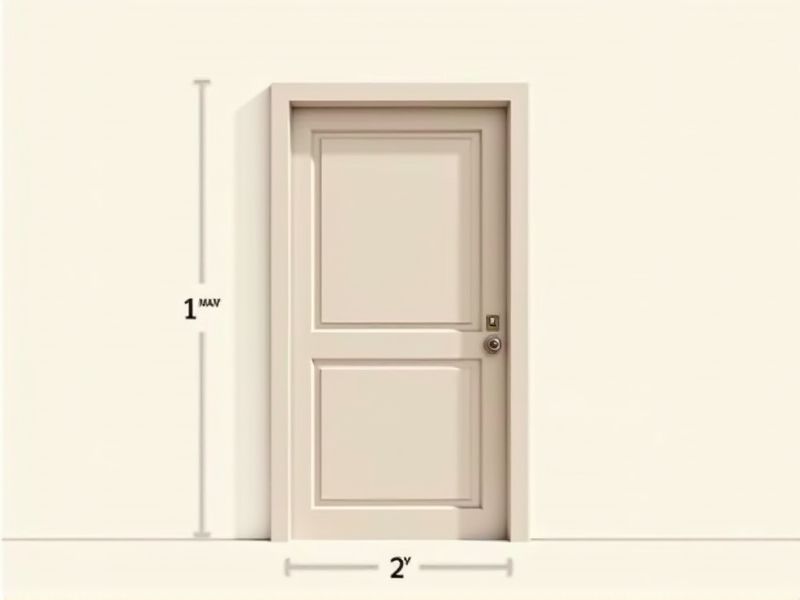
When planning for a new door, it's important to know the standard dimensions to ensure proper fit and functionality. In many residential settings, interior doors are typically 80 inches tall and 30 to 32 inches wide, with a thickness of about 1 3/8 inches. Exterior doors are often slightly wider and thicker, commonly measuring 80 inches in height, 36 inches in width, and 1 3/4 inches in thickness. However, always measure your space before purchasing, as sizes can vary based on region, building codes, and specific design needs.
Height
The standard height for residential doors typically measures 80 inches (203.2 cm). This height is designed to accommodate most individuals, ensuring ease of access while providing aesthetic proportion in the home. For commercial properties, the standard height can vary based on specific regulations but often aligns with the same 80 inches or includes options up to 96 inches (243.8 cm) for taller entryways. When selecting a door, consider variations based on regional building codes and your personal height preference.
Width
The standard door width typically measures 36 inches, accommodating most residential and commercial access requirements. For accessibility purposes, the Americans with Disabilities Act (ADA) recommends a minimum clear opening width of 32 inches for wheelchairs. You may also consider 30-inch doors for smaller spaces; however, this width can restrict movement for larger items. Understanding these dimensions is essential for ensuring compliance with building codes and enhancing usability in your environment.
Thickness
The standard thickness of interior doors typically ranges from 1 3/8 inches to 1 3/4 inches, ensuring durability and sound insulation. Exterior doors usually have a minimum thickness of 1 3/4 inches to enhance security and energy efficiency. Increasing thickness can improve resistance to wear and impact, making it advantageous for high-traffic areas. Selecting the appropriate door thickness is crucial for achieving both aesthetic appeal and functional performance in your space.
Frame Depth
The standard frame depth for a residential door is typically between 4 9/16 inches and 6 9/16 inches, accommodating various wall thicknesses. For optimal insulation and security, a frame depth of 6 9/16 inches is often recommended, especially in newer constructions. Standard hollow-core doors usually require a frame that allows for a proper fit to ensure stability and prevent air leaks. Your choice of frame depth can significantly influence energy efficiency and overall aesthetic appeal in your home's design.
Clearance
The standard door clearance typically ranges from 1/2 inch to 3/4 inch above the finished floor, ensuring smooth operation and preventing dragging. For accessible designs, the clearance may increase to accommodate mobility aids, often requiring a minimum of 1 inch. Proper door clearance not only enhances aesthetic appeal but also aids in air circulation and reduces wear on flooring. Maintaining these standards is vital for both functionality and safety in residential and commercial settings.
Swing Direction
Swing direction is a critical factor in determining door functionality and user convenience. Typically, doors are designed to swing either inward or outward, with the swing direction impacting space utilization and accessibility. For residential and commercial properties, a common standard dictates that exterior doors swing outward to provide safety during emergencies, while interior doors generally swing inward to utilize wall space efficiently. Understanding your specific needs and space layout can help you choose the most suitable swing direction for your doorway.
Material Type
When selecting a door, the material type significantly influences durability, aesthetics, and insulation properties. Solid wood doors, with thickness typically between 1 3/4" and 2", offer excellent insulation and are renowned for their timeless beauty. Steel doors, on the other hand, are often available in standard sizes such as 36" x 80" and provide higher security and energy efficiency. Fiberglass doors, known for their resistance to warping and moisture, often feature a scratch-resistant surface and can be customized to mimic the look of wood at a lower maintenance cost.
Hardware Placement
A well-designed door should prioritize hardware placement to enhance functionality and aesthetics. For example, the average height for door handle installation is 36 inches from the floor, ensuring comfortable access for most users. Proper alignment of hinges, typically installed 7 inches from the top and 11 inches from the bottom, can support weights up to 200 pounds, contributing to durability. When selecting door hardware, consider finishes that complement your interior design while maintaining a minimum of two points of contact for optimal security.
Insulation Capability
The insulation capability of doors plays a crucial role in energy efficiency, with high-performance doors capable of achieving an R-value of 5 or higher. Proper insulation reduces heat transfer, significantly lowering heating and cooling costs, which can be reduced by up to 30% over a year. Look for doors made with materials like fiberglass or insulated steel, as they are designed to minimize thermal bridging. You should also consider the quality of weather stripping, as it can further enhance performance by sealing gaps and preventing drafts.
Accessibility Standards
Accessibility standards for doors mandate a minimum width of 32 inches to accommodate individuals using wheelchairs or mobility aids. The threshold height should not exceed half an inch, ensuring easy entry for all users, including those with visual impairments. Lever handles are preferred over doorknobs as they provide easier operation, requiring less force to open. Compliance with the Americans with Disabilities Act (ADA) ensures your facility is welcoming and accessible to everyone.
